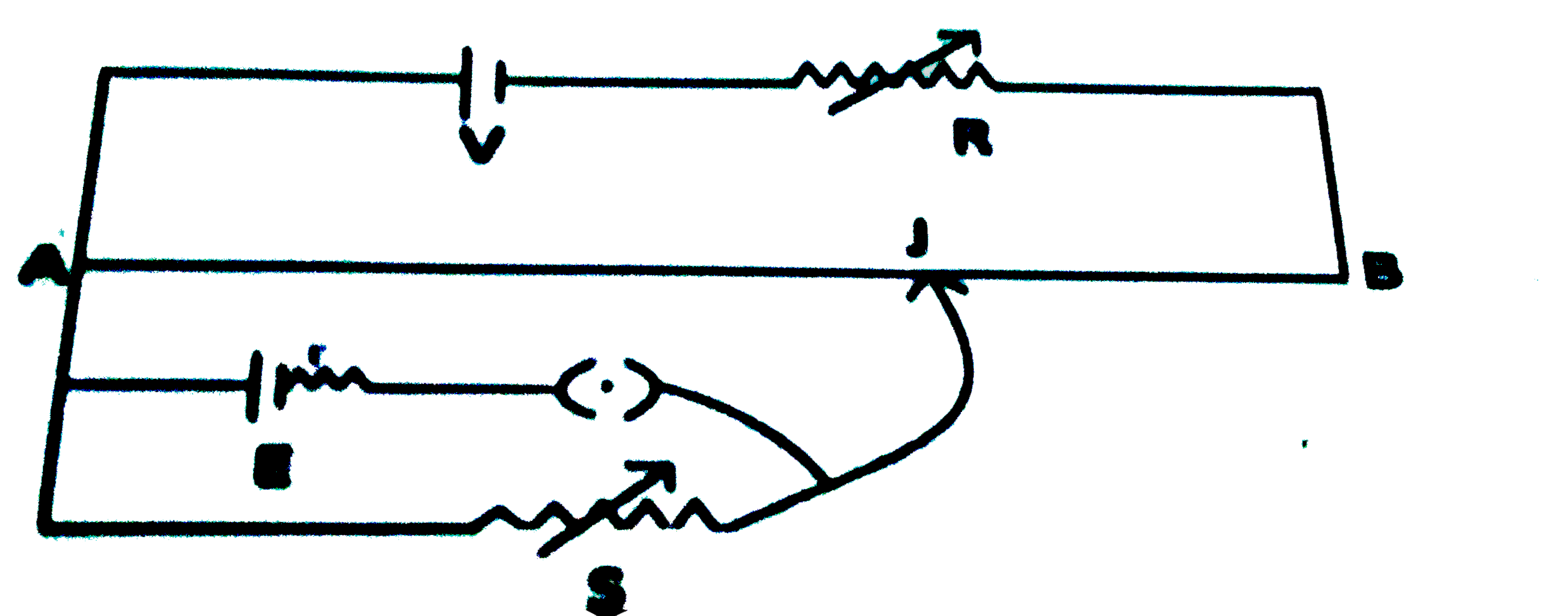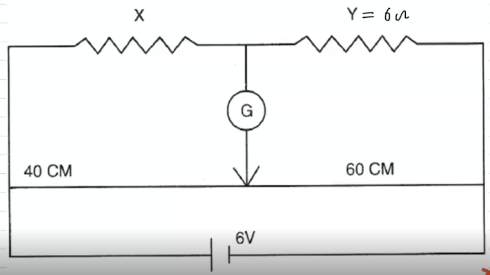State working principle of potentiometer. Explain how the balance point shifts when value of resistor R increases in the circuit of potentiometer, given below.

Principle of potentiometer, when a constant current flows through a wire of uniform area of cross-section, the potential drop across any length of the wire is directly proportional to the length.
Let resistance of wire AB be R1 and its length be 'I' then current drawn from driving cell -
1=VR+R1 and hence
P.D. across the wire AB will be
VAB=1R1=VR+R1×elθa
Where 'a' is area of cross-section of wire AB
∴VABl=Ve(R+R1)a = constant = k
Where R increases, current and potential difference across wire AB will be decreased and hence potential gradient 'k' will also be decreased. Thus the null point or balance point will shift to right (towards, B) side.
Topper's Solved these Questions
- BOOK - XII BOARD PREVIOUS YEAR PAPER ENGLISHCHAPTER - SAMPLE PAPER 2019EXERCISE - SECTION D6videos
SAMPLE PAPER 2019
- BOOK - XII BOARD PREVIOUS YEAR PAPER ENGLISHCHAPTER - SAMPLE PAPER 2019EXERCISE - SECTION B9videos
SAMPLE PAPER 2019
- BOOK - XII BOARD PREVIOUS YEAR PAPER ENGLISHCHAPTER - EXAM REVISION SERIESEXERCISE - All Questions41videos
EXAM REVISION SERIES
- BOOK - XII BOARD PREVIOUS YEAR PAPER ENGLISHCHAPTER - XII BOARDSEXERCISE - SECTION - B7videos
XII BOARDS
Similar Questions
State the working principle of potentiometer. With the help of the circuit diagram, explain how a potentiometer is used to compare the emf's of two primay cells. Obtain the required expression used for comparing the emfs. Write two possible causes for one sided deflection in a potentiometer experiment.
View SolutionAN ideal battery of 4 V and resistance R are connected in series in the primary circuit of a potentiometer of length 1 m and and resistance 5Ω the value of R, to give a difference of 56mV across 10 cm of potentiometer wire , is :
View Solution
Knowledge Check
- Question 1 - Select One
AB is wire of potentiometer with the increase in the value of resistance R, the shift in the balance point J will be
 Atoward BBtoward ACremains constantDfirst towards B then back towards A
Atoward BBtoward ACremains constantDfirst towards B then back towards A - Question 2 - Select One
In a potentiometer of 10 wires, the balance point is obtained on the 7th. To shift the balance point to 9th wire, we should
Adecrease resistance in the main circuit.Bincrease resistance in the main circuit.Cdecrease resistance in series the cell whose emf is to be measured.Dincrease resistance in series with the cell whose emf is to be determined
State the principle of potentiometer. With the help of circuit diagram, describe a method to find the internal resistance of a primary cell.
View SolutionAB is a potentiometer wire Fig. If the value of R is increased, in which direction will the balance point J shift ?
View SolutionIn the given circuit a meter bridge is shown in balanced state. The value of X is
 View Solution
View SolutionA battery of e.m.f. 10 V and internal resistance 2Ω is connected in primary circuit with a uniform potentiometer wire and a rheostat whose resistance is fixed at 998Ω.A battery of unknown e.m.f. is being balanced on this potentiometer wire and balancing length is found to be 50 cm.When area of cross section of potentiometer wire is doubled, then balancing length is found to be 75 cm.
(i)Calculate e.m.f. of the battery.
(ii)Calculate resistivity of potentiometer wire if length of wire is 100 cm and area of cross-section (initially) is 100cm2.View SolutionPassage - II :
Consider a potentiometer arrangement having auniform wire AB of resistance 99Ω

A driving battery of 10V emf and 1Ω internal resistance is used in the potentiometer. A cell of unknown emf E1 and internal resistance of 1Ω is balanced agains AC length of potentiometer wire.
When jockey is touched with wire AB at point C such that AC = 40 cm, there is no deflection in galvanometer. The emf of cell isView SolutionWrite the principle of working of a potentiometer. Describe briefly, with the help of a circuit diagram, how a potentiometer is used to determine the internal resistance of a given cell.
View Solution
